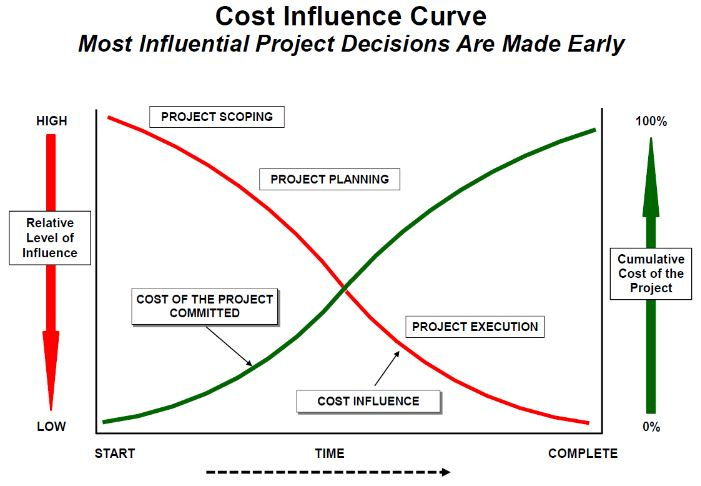Constructability: A Key Step to a Smooth Project
Paving the way for lower costs, better productivity, & earlier project completions.
👋 Hey, Kyle here! Welcome to The Influential Project Manager, a weekly newsletter covering the essentials of successful project leadership.
Today’s Overview:
Constructability is the optimum use of construction knowledge and experience in planning, design, procurement, and field operations to achieve overall project objectives. This practice helps spot issues, propose solutions, fix errors, and ensure a design can be practically built and efficiently operated.
We can't control everything in a project, but we can make sure our plans are good to go. This is where we can really make a difference. Upfront involvement from someone with the right construction knowledge and experience has major benefits to outcomes.
Effective constructability integrates these parts and is one of the most powerful tools owners can use on their projects. As a project manager, improving your skills in constructability review and participation can significantly boost your contribution to a project.
Constructability: A Key Step to a Smooth Project
Constructability is a crucial step for ensuring smoother, more cost-effective, and time-efficient projects.
The projects I've enjoyed and succeeded in the most are those where I was involved from the start. In these, I didn't just start early; I actively contributed my expertise to enhance the team's efforts and streamline the whole process. Planning like this made delivery so much better.
This article aims to amplify the understanding of project leaders about the substantial advantages a constructability effort can deliver - from lowering costs and boosting productivity to hastening project completion and operation initiation.
The message is simple yet powerful: Construction considerations need to be intertwined with every project phase, from feasibility studies and conceptual planning to design, procurement, and the actual construction.
In their insightful book, "How Big Things Are Done," Bent Flyvbjerg and Dan Gardner dig into the world's largest database of big projects.
Their findings underline the central philosophy behind the most successful projects: "Think Slow, Act Fast." This mantra highlights the crucial role of thorough planning and meticulous analysis before diving into project execution - the essence of constructability.
Constructability is about optimizing the plan to mitigate potential hurdles during the project's delivery phase. Projects that fail typically follow the opposite approach: "Think Fast, Act Slow.”
Essentially if you “think fast” during the planning stage of your big project, you’ll be forced to “act slow” in the future while you deal with the challenges of a plan that doesn’t work.
Remember, planning is relatively cheap and safe, while delivery is expensive and dangerous. You want dedicate sufficient time and resources to craft a detailed, tested, and constructive plan, to substantially reduce these risks.
It’s time to embrace constructability to ensure smooth sailing in your projects!
What is Constructability?
Constructability is defined as the optimum use of construction knowledge and experience in planning, design, procurement, and field operations to achieve overall project objectives. (Constructability: A Primer, 1986)
They help projects:
Spot issues that may arise during construction
Propose solutions and fix errors early on.
Ensure that the proposed design can be practically built and efficiently operated.
We can't control everything in a project, but we can make sure our plans are good to go. This is where we can really make a difference.
Upfront involvement from someone with the right construction knowledge and experience has major benefits to outcomes. The earlier, the better!
The Construction Cost Influence curve is a great illustration:
Only through the effective and timely integration of construction input into planning and design as well as field operations will the potential benefits of constructability be achieved.
Of course with any new concept, there are barriers to implementing constructability:
Complacency with the status quo.
Resistance by designers, who view such efforts as an intrusion.
Lack of construction experience in design and construction personnel.
Designers perception that “we do it.”
Lack of mutual respect between designers and construction personnel.
Construction personnel do not respond in a timely manner, and input is too late to be of any value.
Benefits & Current Practices
The Construction Industry Institute has cited cost reductions of between 6 and 23 percent and large schedule reductions.
The intangible benefits are equally as important. These include; more accurate schedules, increased productivity, improved sequence of construction, enhanced quality, decreased maintenance, and a safer job.
Projects that emphasize good constructability have four common characteristics:
Both the owner and contractor (design and construction) managers prioritize the project's overall cost-effectiveness, understanding the significant impact of initial decisions on costs.
They leverage constructability as a primary tool to achieve project goals related to cost and timeline.
Managers involve construction expertise at an early stage. This involves selecting experienced individuals who have comprehensive knowledge of how a project is planned and executed, rather than merely opting for those who are conveniently available.
Designers are open to enhancements in constructability, actively seeking construction feedback and assessing it without bias.
Constructability Case Study: The Empire State Building
The Empire State Building stands as a prime example of the power of effective constructability efforts.
Within just 20 months, the building was planned, engineered, granted permits, had the existing structure torn down, and the new building was constructed. On time and under budget. This achievement was due, in no small part, to a relentless focus on optimizing every element for constructability and efficiency.
The building's developers, Empire State, Inc., understood that the project's design could not rest solely in the hands of architects.
A building committee was formed, including owners, architects, engineers, consultants, and agents. Their goals were clear - collaborate to make this project a success.
Regular meetings facilitated open communication between all parties. This environment of cooperation helped to swiftly resolve potential issues and expedited decision-making.
In planning the building, Lamb’s focus was intensely practical. Working closely with the project’s builders and engineers, Lamb developed designs shaped by the site and the need to stay on budget and schedule.
The designs were rigorously tested to ensure that they would work. Hardly a detail was issued without having been thoroughly analyzed by the builders and their experts and adjusted and changed to meet every foreseen delay.
The Empire State Building had been estimated to cost $50 million. It actually cost $41 million ($679 million in 2021). That’s 17% under budget. Construction finished several weeks before the opening ceremony.
Explore the details about this project and its innovative approach by reading the full story here.
Implementation: Constructability Concepts
A constructability program is not a one-size-fits-all solution. It must be tailored to the user.
While the structure and emphasis of such programs may vary across organizations and projects, certain fundamental components are non-negotiable.
Every robust constructability program should:
Explicitly demonstrate senior management's dedication to constructability, inspiring similar commitment throughout the project team.
Encourage teamwork, creativity, new ideas, and new approaches.
Assign a program director equipped with leadership acumen, effective communication abilities, and an in-depth understanding of the organization's workflow.
Start constructability as early as possible.
Prioritize the integration of the project as a whole, rather than optimizing isolated components.
Define a clear constructability process to be integrated into project execution strategies.
Regularly assess the program's performance and outcomes.
Fundamental Constructability Principles:
Let construction needs dictate the overall project schedule.
Designs should prioritize and facilitate efficient construction.
Layouts should favor both efficient construction, and easy operation and maintenance.
Lean towards modular or pre-fabricated designs, simplifying fabrication, transportation, and installation stages.
Standardize design elements wherever possible.
Ensure design layouts accommodate hassle-free access for staff, materials, and machinery during the construction phase.
Next, let’s look at some examples of constructability thought. The following construction concepts have been identified to help during the planning/design stage.
These comments should not be considered as a cook book, but are shown to promote thought on the part of the designer or construction personnel.
Logistics:
Are areas available for; stockpiling materials, material lay down, fabrication yards, equipment parking, temporary field offices, personnel parking, and purchased material storage? If areas can be secured without excessive cost, efficiency during construction will improve.
Will doubling handling of materials be involved? Is there sufficient space on project for temporary stockpiling?
Will weather or local conditions become a factor for the successful completion of the job?
Are materials readily available in this locale for the design requirements?
Material Selection/Procurement:
Are there potential compatibility issues among the chosen materials and/or installation details?
Do selected materials satisfy the acoustic, thermal, and aesthetic requirements of the space?
How might the material choices influence the project timeline?
Walls & Ceilings:
Can standard equipment be used to execute the work?
Have the soundproofing requirements for each area been factored into the wall design?
Are there any potential challenges with wall-mounted equipment, such as TV brackets or shelving?
Do any special finishes or wall coverings impact the construction process?
Are there built-in elements like recessed cabinets or fixtures, and how do they influence the construction?
Mechanical, Electrical, Plumbing (MEP):
Can the finished product be accessed for routine maintenance and repair?
Does the HVAC design account for the unique needs of specialized areas like server rooms or kitchens?
Can the systems be conveniently expanded or altered later?
Is there adequate space designated for HVAC installation and duct routing?
Does the electrical design cater to specific power needs, including high-power elements and all mechanical equipment?
Is the placement of clean-outs optimized for accessibility?
Are water heating and re-circulation systems incorporated where needed?
These questions can guide managers to ensure the designs they review are practical, efficient, and safe.
Final Takeaways
There are many benefits to constructability reviews during the design phase of a project. These benefits greatly outweigh the costs associated with it.
The ultimate goal of constructability is to reduce the number of unknowns going into the construction phase, leading to a safer worksite with fewer quality issues, and less downtime.
So I urge readers to “Think slow, Act fast.” Put the extra effort in upfront.
There is also an education portion to constructability which leads to better designs in the future. Although constructability is considered in many designs, there is still a need to promote it and create greater awareness. After all, who can afford to pass up constructability benefits!?
I'm genuinely interested in your perspective:
What are your experiences with constructability?
Do you have any good stories or learning’s to share?
Let me know your thoughts.
Until next week,
Kyle Nitchen
📢 Your Opinion Matters!
I'm committed to making my newsletters as relevant and useful to you as possible.
To help me with that, could you take a moment to tell us what topics or issues you'd like me to explore? Share your thoughts in this poll or by replying to this email.

Before you go, here’s how I can help:
Upgrade your PM software. Project financials, management, and construction admin. Switch to INGENIOUS.BUILD to evolve from an administrative project manager to strategic project leader.
Get my full toolbox (free). It contains 30+ software and hardware tools I’m using today.
Hold your schedule accountable. Gain stability and flow in your projects with this Takt Planning & Control online course. Use code “Influentialpmtakt” for 30% off!
Advertise in this newsletter. Put your brand in front of 2,700+ construction project managers, leaders, and execs. (Booked out 5 weeks)
Support this Newsletter. The Influential Project Manager articles will remain free, but if you find this work valuable, I encourage you to become a paid subscriber. As a paid subscriber, you’ll help support this work.





